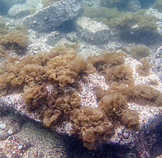
Primary Producers
Primary producers are organisms with the ability to convert inorganic materials into organic materials to be used as food. They are the basis of all food webs. In the soft shore ecosystem, the flora and algae (both micro- and macroscopic) play a significant role as primary producers.
The following is a list of representative species from each group of primary producer that can be found in Hong Kong.
True Mangroves
.jpg)
Kandelia obovata
Photo taken at Mai Po
by Joe Lee
.jpg)
Aegiceras corniculatum
Photo taken at Mai Po
by Yan Ping Loo
Common name: river mangrove
.jpg)
Avicennia marina
Photo taken at Lai Chi Wo
by Joe Lee
Common name: grey mangrove
.jpg)
Bruguiera gymnorhiza
Photo taken at Lai Chi Wo
by Joe Lee
Common name: large-leafed orange mangrove, oriental mangrove
_edited.jpg)
Acanthus ilicifolius
Photo taken at Mai Po
by Yan Ping Loo
Common name: sea holly, holly mangrove
.jpg)
Acrostichum aureum
Photo taken at Mai Po
by Yan Ping Loo
Common name: golden leather fern
.jpg)
Lumnitzera racemosa
Photo taken by Joe Lee
Common name: white-flowered black mangrove
.jpg)
Heritiera littoralis
Photo taken at Lai Chi Wo
by Joe Lee
Common name: looking-glass mangrove
.jpg)
Excoecaria agallocha
Photo taken at Lai Chi Wo
by Joe Lee
Common name: blinding tree, milky mangrove
_edited.jpg)
Sonneratia spp.
Photo taken at Mai Po
by Yan Ping Loo
Common name: mangrove apple
**Invasive species
Sonneratia caseolaris and Sonneratia apetala are two invasive mangrove species that occur in the Deep Bay (aka Shenzhen Bay). They were introduced to Shenzhen as part of a project to afforest the coast of Shenzhen Bay. Their seedlings eventually spread to the Hong Kong side of the Bay, where they proliferate due to their high growth and reproduction rates.
Mangrove Associates
.jpg)
Derris trifoliata
Photo taken at Mai Po
by Yan Ping Loo
.jpg)
Cerbera manghas
Photo taken by Joe Lee
Common name: sea mango
.jpg)
Talipariti tiliaceum
Photo taken by Joe Lee
Common name: sea hibiscus
_tif.png)
Clerodendrum inerme
Photo taken by Joe Lee
Saltmarsh Plants
.jpg)
Suaeda australis
Photo taken at Lai Chi Wo
by Joe Lee
Common name: austral seablite
.jpg)
Cyperus malaccensis
Photo taken at Mai Po
by Yan Ping Loo
Common name: short-leaved Malacca galingale

Panicum repens
Photo taken at Lai Chi Wo
by Joe Lee
Common name: torpedograss
Seagrasses
_edited.jpg)
Zostera japonica
Photo taken at Lai Chi Wo
by Joe Lee
Common name: Japanese eelgrass, drawf eelgrass
_edited.jpg)
Ruppia maritima
Photo taken at Mai Po
by Yan Ping Loo
Common name: widgeon grass
Microalgae
.jpg)
Microphytobenthos (MPB)
MPB extracted from sediment in the mangrove forest, viewed under a phase-contrast microscope at 400X.
The MPB is a major food source to grazers in both mangrove forests and tidal flats. Organisms that feed on them are such as bowed fiddler crab (Tubuca arcuata) in the mangrove forest, and great blue-spotted mudskipper (Boleophthalmus pectinirostris) on the tidal flat.
.jpg)
Phytoplankton
Phytoplankton extracted from the subtidal surface water, viewed under a phase-contrast microscope at 10X.
Phytoplankton drift along with the tides, and they feed marine organisms such as greenback mullet (Planiliza subviridis) and false cockle (Anomalodiscus squamosa).
Macroalgae


Ulva spp.
Photos taken by Wai Hong Yiu
Common name: green algae
Macroalgae are a diverse group of multicellular plant-like organisms. They share some physiological characteristics with plants, such as the ability to photosynthesize through light harvesting pigment, but they are not regarded as plant. They should be distinguished from seagrass, which is the flowering plant with vascular tissues for transportation of water and nutrients. Macroalgae commonly found in the marine environment are called seaweed. Some particular species of seaweed, such as the green algae (Ulva spp.), could be found at the soft bottom of estuaries. Occasionally, some brown algae (Colpomenia sinuosa) could be found in the relatively saline environment in the estuarine area.



Colpomenia sinuosa
Photos taken by Wai Hong Yiu
Common name: brown algae
